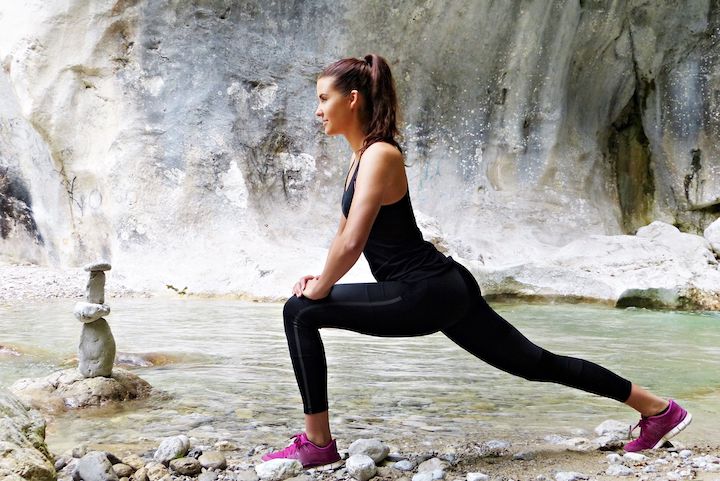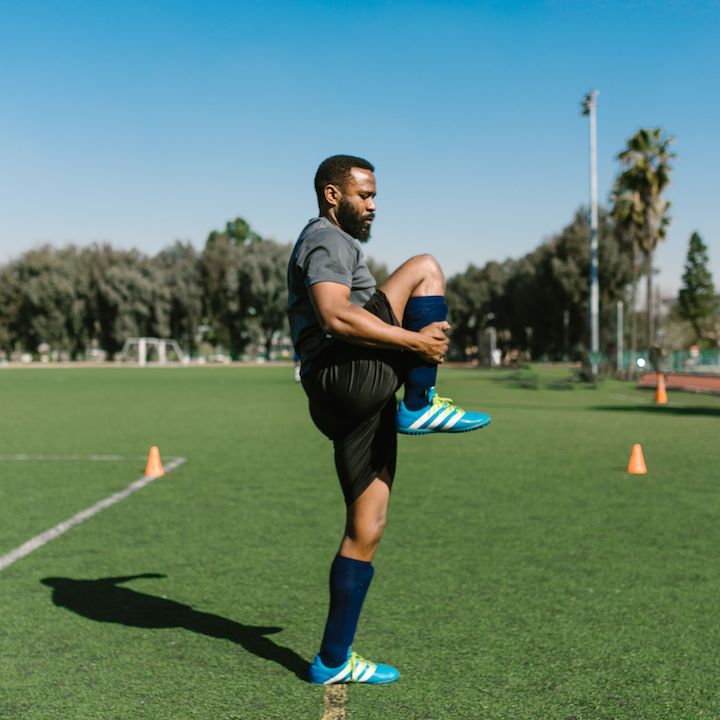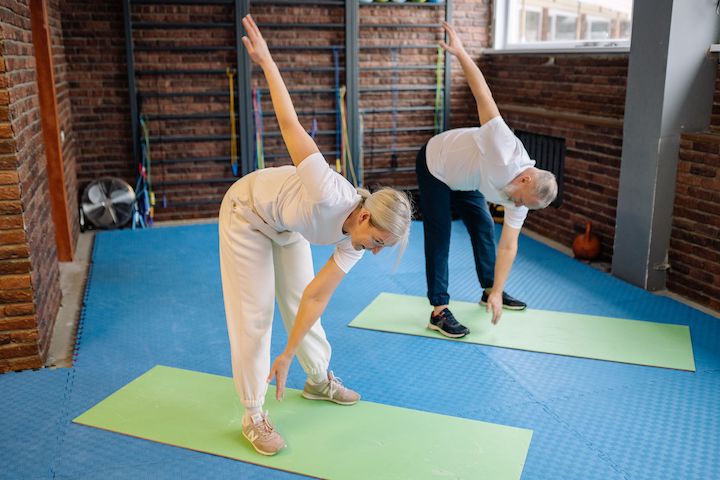

Stretching is an essential part of physical therapy, like a key unlocking a door to a healthier, more flexible body. As the saying goes, ‘If you don’t use it, you lose it,’ and this is especially true for the muscles and joints in our bodies.
It can help maintain and improve range of motion, reduce pain, and even improve performance. In this article, we’ll explore the importance of stretching in physical therapy and how it can benefit you. So grab a yoga mat and get ready to learn more about this invaluable practice!
You know the feeling of being stiff and achy? Stretching is an essential part of taking care of your body. When done properly, it can help reduce stiffness and soreness, improve flexibility and range of motion, and reduce muscle tension.
It can also help increase blood flow to certain areas of the body, improving circulation and helping to facilitate muscle relaxation. When performing stretching exercises, it’s important to maintain proper form and use slow, controlled movements. This will help ensure that you’re stretching the muscles in the correct way and avoid straining or injuring them.
Additionally, it’s important to hold each stretch for at least 10-30 seconds and to breathe deeply while doing so. When done correctly, it can help you stay limber and relaxed, preparing your body for any physical activity that might come your way.
Through regular stretching, you may experience improved posture, increased range of motion, and reduced risk of injury. Not only that, but it can also bring about a number of additional benefits:
Stretching offers a great way to reduce stress and improve your overall well-being. It also helps to improve posture, reduce the risk of injury, and increase your range of motion.
 Photo Credit: Andrea Piacquadio
Photo Credit: Andrea Piacquadio
Taking the time to stretch regularly can help you feel more relaxed and energized throughout the day. It can also help to improve your concentration and mental clarity, making it easier to stay focused on your work or studies.
In addition, it can help to reduce muscle tension and improve your overall flexibility. The combination of these benefits can make a big difference in your physical and mental health. By taking the time to stretch regularly, you can improve your overall physical health and well-being.
By incorporating various types of stretches into your fitness routine, you can maximize its benefits and enhance your overall physical health. There are several types of stretching that can be used to improve flexibility, reduce muscle tension, and improve recovery time.
Static stretching is the most common type of stretch, which involves stretching a muscle to its furthest point and holding it for a period of time. This type increases flexibility and reduces muscle tension.
Dynamic stretching is another type of stretching that is often used to warm up muscles before physical activity. This involves stretching the muscles through a range of motion with a slow, controlled movement.
Ballistic stretching is another type that involves bouncing rapidly through a range of motion. This type can increase the flexibility of a muscle, but it can also lead to injury if done incorrectly.
All types of stretching should be done for a duration of 10 to 30 seconds to maximize the benefits and reduce the risk of injury.
Learning different stretching techniques can help keep you agile and injury-free, so it’s wise to stay on top of the latest trends in the fitness world.
 Photo Credit: Silvia Rita
Photo Credit: Silvia Rita
Adding some stretching routines to your workout plan can help your body stay in top form and prevent possible injuries. Here are some of the most popular stretching techniques:
Stretching can be a great addition to your exercise routine and can help you become more agile and reduce the risk of injury. Be sure to talk to your physical therapist about what techniques would be best for you and your specific needs.
Stretching your muscles at the right times can make all the difference in your overall fitness and health. Muscle tension can build up, especially in athletes or those who are physically active, and regular stretches can help to prevent this build-up.
Knowing when to stretch is just as important as knowing how to do it correctly. It’s best to stretch after a warm-up, such as light cardio, or after physical activity. This helps to loosen the muscles, increase flexibility, and reduce the chance of injury.
 Photo Credit: RNDE Stock Project
Photo Credit: RNDE Stock Project
Stretch frequency also depends on the individual and their activity level. For those who are highly active or involved in sports, a few stretches after each activity is recommended. For those who are not as active, stretching three to four times a week is sufficient.
Stretching should be done slowly and gently without bouncing. It’s important to pay attention to your body and stop if you feel any pain or discomfort. It can be a great way to help your body stay strong and flexible and to take care of any muscle tension.
You should always be mindful of your safety when taking some stretches – take it slow and listen to your body so you can stay safe and gain maximum benefit from it.
Here are some important safety considerations to keep in mind:
Stretching is an important part of physical therapy, but it’s important to keep safety at the forefront of your mind. Following these safety considerations can make all the difference in helping you to stay safe, and to maximize the benefit you gain from your routines.
It’s crucial to understand how it can benefit various conditions, so let’s explore the different ways it can help.
Stretching is an important component of any physical therapy regimen, as it can help to alleviate muscle imbalance and poor posture caused by injury or overuse. It is often used in combination with other physical therapies, such as therapeutic exercise and manual therapy, to promote healing and reduce pain.
 Photo Credit: Yan Krukau
Photo Credit: Yan Krukau
Stretching can also be used to help people with chronic conditions like arthritis and fibromyalgia. For those with these conditions, it can help to improve joint mobility and decrease pain. It can also help to increase flexibility and range of motion, helping to reduce the risk of future injury.
Additionally, stretching can help to improve balance and coordination, which can be beneficial for those with balance or coordination issues.
Gaining a professional’s help can make all the difference in increasing mobility and decreasing pain, so don’t hesitate to reach out and get the support you need.
Working with a therapist can help you determine the best stretching routine for your unique needs and capabilities, as well as provide professional guidance on proper form and technique. With their expertise, you can be sure that the exercises you perform are safe and effective.
You may not be able to progress at the same speed as someone with a different condition, but your therapist can help you make steady progress. Your therapist can also help you understand the importance of stretches and how it can help you prevent or reduce pain and improve mobility.
With professional help, your stretches can be tailored to your individual needs and progress can be monitored over time.
Stretches are an important part of any physical activity and physical therapy is no exception. To get the most out of your physical therapy, you should be stretching regularly.
Dynamic stretching, which is active stretching, should be done before exercise, while static stretching, which is slower and more controlled, should be done afterwards.
Aim for a few minutes of each type of stretching at least 3 times per week and you’ll be well on your way to maximizing the benefits of physical therapy.
You don’t have to spend hours stretching your muscles every day to enjoy the benefits of stretching. A good rule of thumb is to hold each stretch for at least 15 to 30 seconds. This allows your muscles to fully relax and allows you to get the most out of the stretch.
Doing this regularly helps to improve your flexibility and range of motion, reduce pain and stiffness, and increase circulation. Stretching frequency is a key factor for pain relief, so make sure to stretch regularly for the best results!
When it comes to stretching, the type you should use depends on your particular condition. Generally speaking, stretching intensity should be determined based on the specific area of your body and the severity of your condition.
Stretching technique should also be tailored to your body’s needs. For example, if you’re dealing with chronic pain, then static stretching is usually the best option. If you’re trying to improve your flexibility, then dynamic stretching might be the best choice.
Ultimately, the type of stretching that’s best for you will depend on your individual needs.
You’ve been given a stretching routine to follow, but you’re wondering if there’s a specific order you need to do the stretches in to get the most out of them. The answer is yes!
The order in which you do your stretches can be as important as the type of stretching you’re doing. The key is to use repetitive techniques, starting with the larger muscle groups and gradually working down to the smaller muscles.
This will ensure that you’re giving your body a thorough stretch, and that you’re not neglecting any areas. Doing the stretches in this order will also help you maximize the benefits of your stretching routine.
You may already know that stretching is beneficial for your body, but it’s important to understand the proper technique and safety.
Overstretching can cause further injury, especially if you lack flexibility or you don’t warm up your muscles before stretching. To prevent this, make sure you move slowly throughout the stretch, using your breath to guide your movements.
You should never push your body beyond what feels comfortable and only do stretches that are appropriate for your level of flexibility.
You may be wondering if stretching is really worth the effort. Absolutely! It can help improve flexibility, range of motion, posture, and even reduce the risk of injury. It’s also a great way to relax and reduce stress.
Plus, it can be tailored to fit your particular condition, so there’s no need to worry about overdoing it. But what if stretching doesn’t seem to help? Don’t give up!
Consult a physical therapist to discuss your individual needs and find a program that is safe and effective for you. With the right guidance, stretching can be an important part of your physical therapy routine.
There are no results matching your search.
Reset